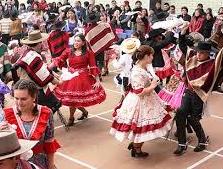First of all, we can state that there are several theories about the etymological origin of the word cueca. However, one of the most widely accepted is to determine that it derives from “clueca”, which refers to the hen singing after having laid an egg.
The cueca is a dance originally from South America , traditional in countries such as Argentina , Bolivia , Chile , Colombia and Peru . In this dance, people move a handkerchief held in their right hand while performing half-turns, spins, and flourishes.
 This dance is danced as a couple , made up of a man and a woman . It is generally assumed that when a man invites a woman to dance a cueca, he wants to woo her, although romantic interest is not an essential condition for dancing.
This dance is danced as a couple , made up of a man and a woman . It is generally assumed that when a man invites a woman to dance a cueca, he wants to woo her, although romantic interest is not an essential condition for dancing.
The origins of the cueca are not clear, although Spanish, African and Aboriginal influences are noted. It is believed that the zamacueca emerged from the jota and the fandango , from which the cueca would derive.
It is important to keep in mind that the cueca developed in different ways depending on the country. That is why it is possible to differentiate between the Chilean cueca , the Bolivian cueca , the Argentine cueca , etc. In addition, there are numerous subgenres within each national cueca: the porteña cueca , the brava cueca , the tarijeña cueca , the cuyan cueca and others.
In Chile it is one of the countries where the cueca is most important. In this country it is considered that its origin is possibly in the black slaves who arrived to this land on their way to Peru. However, it is true that there are different theories in this regard.
In the cantinas, during the 19th century, this dance spread and became most popular both inside and outside the country. And it is considered that precisely thanks to Chilean adventurers and sailors it reached other corners of the world, such as, for example, Mexico.
Regarding the composition as such, it should be noted that in Chile it is made up of fourteen verses that are distributed over a total of four stanzas, which are a copla, two seguidillias and a ending. In the same way, we must not overlook that it lasts less than 2 minutes and that it takes place in a 6/8 rhythm.
To all of the above, we must add that there are many topics that can be discussed in a cueca. However, among the most common are historical events, love in all its extension and picaresque issues.
It should be noted that the cueca, in addition to being a dance, is a musical genre . Cueca compositions are usually performed with instruments such as the guitar , harp, piano, double bass, accordion and drums.
Although the cueca lost popularity as the 20th century progressed, it still remains an important part of South American folklore . Chile , for example, declared the cueca its “national dance” in 1979 , while a decade later it established National Cueca Day (September 17). Bolivia , for its part, named the Bolivian cueca as part of the country's cultural heritage in 2015 .
